Soldering polypropylene pipes: work rules and analysis of possible errors
The ability to assemble pipelines independently is an undoubted plus of polypropylene products. Using a convenient and lightweight material, you can build a sewer yourself, repair and upgrade the water supply system.
The main thing is to understand the specifics of connecting prefabricated elements together. Agree, this is an important part of the work responsible for the tightness of the line and its trouble-free operation.
We offer you detailed information on how to solder polypropylene pipes, what equipment is used in the work, and also list the most common mistakes of novice welders.
The information we offer will help you build reliable communications. For visual perception, the article is supplemented by graphical applications and a video guide.
The content of the article:
The specifics of soldering pipes made of polypropylene
The soldering process is carried out thanks to the pronounced thermoplastic properties of the material. Polypropylene softens when heated - it acquires a state similar to plasticine.
Technology Overview
The return of the material to the conditions of a normal temperature background helps to harden its structure to a normal state.These properties have become the main technology of soldering, which is technically called polyfusion welding.
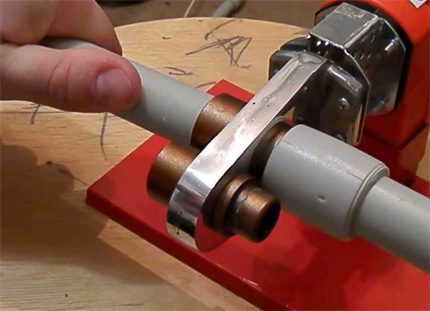
In practice, two methods are used for joining the parts to be welded:
- Coupling.
- Straight.
Coupling method. Welding technique shows how to solder polypropylene pipesusing a shaped part for this - a sleeve or pipe of a larger external diameter. Usually in this way the soldering of plastic pipes is carried out, the diameter of which does not exceed 63 mm.
The principle of welding two parts in this case is based on the melting of the pipe part along the outer circumference and the part of the coupling along the inner region. Then both parts fit tightly together.
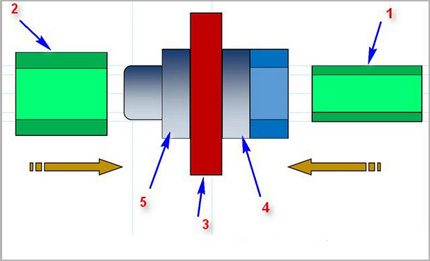
Direct way. The method is based on the same principle of melting small sections of plastic pipes with their subsequent joining. But in this embodiment, the butt elements are two pipes of the same diameters, and they are joined by the end surfaces.
This, at first glance, a simple method of soldering polypropylene requires high precision machining of the joints and the exact installation of two parts along the axes during their soldering.
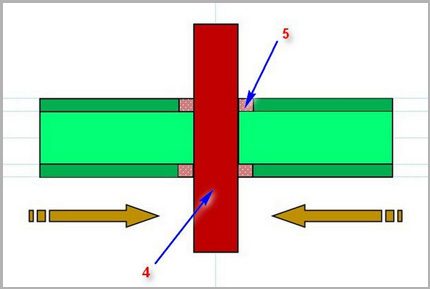
Along with the designated “hot” technologies, the technique of “cold” soldering is also practiced. Here, a special solvent is used as an active soldering component, capable of softening the structure of polypropylene. However, such a technique does not differ in high level of popularity.
Pipe Welding Soldering Machines
Both the sleeve and direct methods require soldering plastic pipes with special welding machines. Structurally, the soldering technique is something like an electric iron.
The basis of the devices is a massive metal heating element, on the surface of which removable nozzles are installed - metal ingots of different diameters. Such a soldering iron is called welding iron.
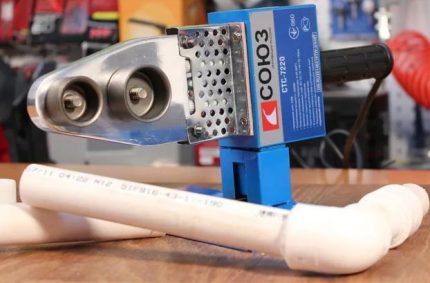
For performing butt welding, the designs of soldering devices are of increased complexity. Typically, such a technique includes not only a heating element, but also a centering system for the parts to be welded.
As a rule, direct welding equipment, like the technology itself, is rarely used in the domestic sphere. The priority is industry.
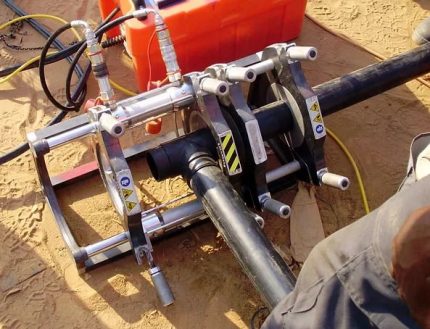
In addition to soldering irons, the master will also need:
- scissors - pipe cutter for polypropylene pipes;
- building roulette;
- square metalwork;
- shaver for pipes with reinforcement;
- marker or pencil;
- surface degreasing agent.
Since the work is carried out on high-temperature equipment, it is imperative to wear tight work gloves.
Polypropylene Welding Procedure
Important caution! Welding of polymeric materials should be carried out in conditions of good ventilation of the room. When polymers are heated and melted, toxic substances are released, which in a certain concentration have a serious effect on human health.
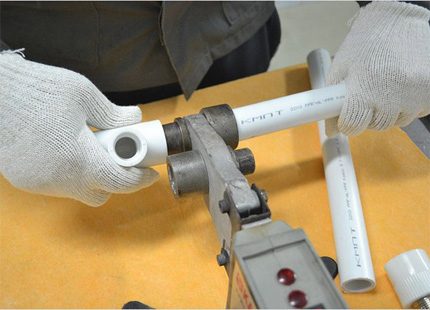
The first thing you need to get ready for work:
- On the plateau of the heater install the blanks of the desired diameter.
- Regulator soldering temperatures set to 260ºС.
- Prepare the mating parts - mark, chamfer, degrease.
- Turn on the soldering station.
- Wait for a set of operating temperature - turning on the green indicator.
Mate parts (pipe - coupling) at the same time fit onto the soldering station blanks. In this case, the polypropylene pipe is inserted into the inner region of one disc, and the sleeve (or socket of the shaped part) on the outer surface of the other disc.
Typically, the ends of the pipe are inserted along the boundary of the previously marked line, and the sleeve is fully inserted. Sustaining polypropylene parts on preheated discs, one should keep in mind the important nuance of the technology - holding time.
If there is insufficient exposure to time, there is a risk of obtaining a low degree of diffusion of the material, which will affect the quality of the junction. If it is overexposed parts, then the risk of deformation of the product structure is high. This is fraught with deterioration in the quality of adhesions.
It is recommended to use the table, which indicates the optimal time for pipes with different technical parameters.
PP brazing time table
| Conventional pipe diameter, mm | Heating time for optimal diffusion, sec | The time to solder parts, sec | Time for cooling parts, min |
| 20 | 5-8 | 8 | 2 |
| 25 | 7-11 | 10 | 3 |
| 32 | 8-12 | 12 | 4 |
| 40 | 12-18 | 20 | 5 |
After holding the parts on the blanks for an optimal period of time, they are removed and quickly joined by the heated parts. The joining procedure must be performed clearly, quickly (in time in the table), subject to the alignment of the soldered parts.
It is allowed to make minor adjustments along the axes (within 1-2 seconds), but turning the parts, one relative to the other, is unacceptable.
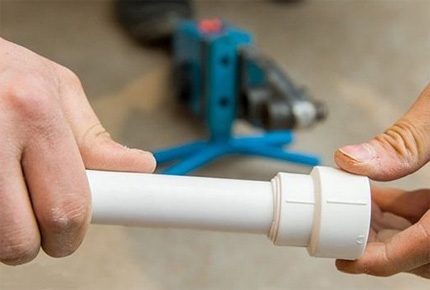
The indicated soldering time of any polypropylene pipes can be adjusted depending on the conditions of work and material indicators.
For example, if the installation is carried out at sub-zero ambient temperatures, naturally the specified standards increase to 50% of the nominal value. For each individual non-standard conditions, the heating time is selected by trial soldering.
Soldering pipes with reinforcement
Consider how to solder reinforced polypropylene pipes. It is mandatory to remove the protective material. The presence of a reinforced layer (aluminum foil) in the pipe structure requires additional heating. But this is not the point.
Typically, such products have an increased diameter and do not fit standard soldering iron tips. They need to be cleaned before the soldering process. An exception is fiberglass reinforced pipes. They are soldered as standard.
Given the variety of technologies for reinforcing polypropylene pipes, various processing methods are used before soldering. Traditionally, a stripper is used for stripping.
This name has a special device in the form of a metal sleeve with knives. The shaver is put on the end part of the pipe to be soldered, and by rotational movements around the axis of the pipe they clean the reinforced layer to clean plastic.
If the reinforced layer is located in the middle of the wall of the plastic pipe, here it is more reasonable to use another tool for processing - a plastic pipe trimmer.
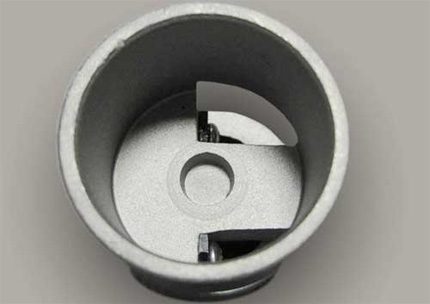
The device is not much different from the seamstress, with the exception of the placement and design of the cutting elements. After machining with a torse cutter, the end of the pipe is aligned along the end, plus a part of the reinforced layer is cut to a depth of 2 mm around the entire circumference. This treatment allows you to perform soldering without defects.
The effect of errors on welding quality
Slow, carefully considered actions are a guarantee against errors that can negate all work. All the details of soldering technology should be taken into account and not a step away from them.
Common errors that result in defective nodes of a mounted propylene water supply network:
- The pipe surface was not cleaned of grease film.
- The cutting angle of the mating parts differs from the value of 90º.
- Loose fit of pipe end into fitting.
- Insufficient or excessive heating of the soldered parts.
- Incomplete removal of the reinforced layer from the pipe.
- Correction of the position of parts after the polymer has set.
Sometimes, on high-quality materials, excessive heating does not give visible external defects. However, an internal deformation is noted when the molten polypropylene closes the inner passage of the pipe. In the future, such a node loses its working capacity - it quickly becomes clogged and blocks the flow of water.
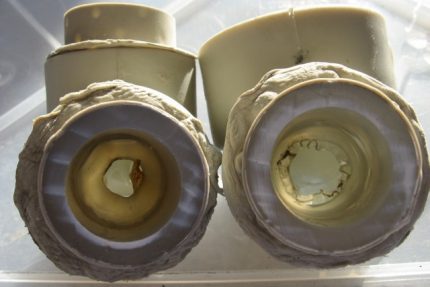
If the cutting angle of the end parts differs from 90º, at the moment of joining the parts the ends of the pipes lie in a beveled plane. Misalignment of parts is formed, which becomes noticeable when a line several meters long is already mounted.
Often, for this reason, you have to redo the entire assembly again. Especially when laying pipes in gates.
Poor degreasing of articulated surfaces contributes to the formation of "islands of rejection." At such points, polyfuse welding does not occur at all or partially.
For a while, pipes with a similar defect work, but at any moment a rush may form. Errors associated with a loose fit of the pipe inside the fitting are also common.
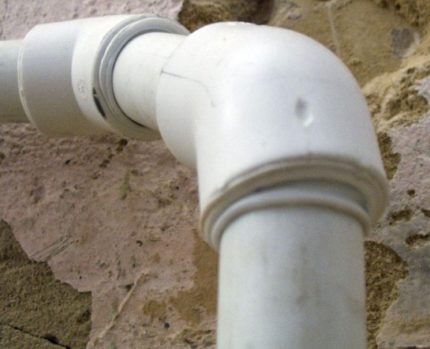
A similar result is shown for compounds made with incomplete cleaning of the reinforcing layer. As a rule, a pipe with reinforcement is placed on high pressure lines. Residual aluminum foil creates a non-contact zone in the solder area. It is at this point that leaks often occur.
The worst mistake is an attempt to correct soldered elements with scrolling around the axis relative to each other. Such actions sharply reduce the effect of polyfusion welding.
Nevertheless, at some points a spike is formed, and the so-called “tack” is obtained. With a small tensile force, the tack holds the joint. However, if you just put the connection under pressure, the adhesion will immediately fall apart.
Additional information on welding polypropylene pipes is provided in this article.
Conclusions and useful video on the topic
Professionals always have something to learn. How to work with polypropylene can be seen in the following video:
Mounting pipelines made of polymers by soldering them “hot” is a convenient and popular technique. It is successfully used in the installation of communications, including at the household level.
This welding method can be used by people without experience. The main thing is to correctly understand the technology and ensure its accuracy. And technological equipment can be bought or rented.
Have experience soldering polypropylene pipes? Please share information with our readers. You can leave comments and ask questions on the topic in the form below.

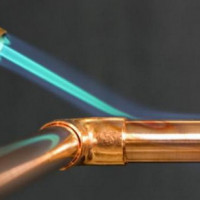 Soldering of copper pipes: step-by-step analysis of work and practical examples
Soldering of copper pipes: step-by-step analysis of work and practical examples 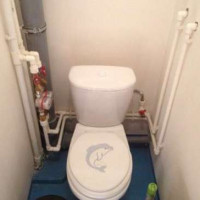 Replacing pipes in the toilet from A to Z: design, selection of building materials, installation work + error analysis
Replacing pipes in the toilet from A to Z: design, selection of building materials, installation work + error analysis 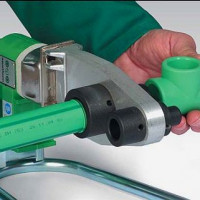 DIY installation of polypropylene pipes: technology for working with PP piping
DIY installation of polypropylene pipes: technology for working with PP piping 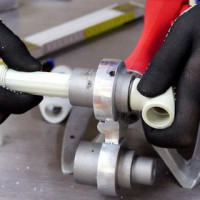 DIY welding technology for polypropylene pipes: an overview of methods and nuances
DIY welding technology for polypropylene pipes: an overview of methods and nuances 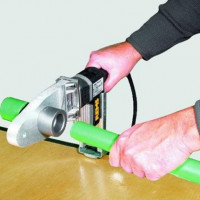 Welding machine for polypropylene pipes: classification, rating of the best + selection tips
Welding machine for polypropylene pipes: classification, rating of the best + selection tips 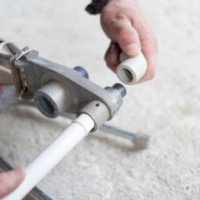 Plumbing pipe connection methods: an overview of all possible options
Plumbing pipe connection methods: an overview of all possible options  How much does it cost to connect gas to a private house: the price of organizing gas supply
How much does it cost to connect gas to a private house: the price of organizing gas supply  The best washing machines with dryer: model rating and customer tips
The best washing machines with dryer: model rating and customer tips  What is the color temperature of light and the nuances of choosing the temperature of the lamps to suit your needs
What is the color temperature of light and the nuances of choosing the temperature of the lamps to suit your needs  Replacement of a geyser in an apartment: replacement paperwork + basic norms and requirements
Replacement of a geyser in an apartment: replacement paperwork + basic norms and requirements